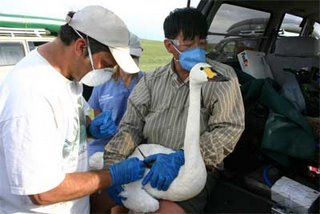When these situations arise the US, World Bank, IMF and other entities are there to lend financial support. Ms. Levine’s premise is that such interventions are not charity, but preventive medicines to isolate and ‘cure’ an ailing economy before the red ink washes upon our shores.
 The essay proposes that we treat global health problems as we do global financial problems and drastically increase aid. Ms. Levine suggests that spending more on health care for developing nations will act as an investment that keeps such problems away from us.
The essay proposes that we treat global health problems as we do global financial problems and drastically increase aid. Ms. Levine suggests that spending more on health care for developing nations will act as an investment that keeps such problems away from us. Agreed. Better healthcare in China equals better healthcare in the West–remember SARS? But redistributing wealth on a grand scale to achieve this goal is not the sole answer. Let’s look at AIDS as a global health problem.
AIDS awareness spending is higher than ever. Few Americans (3% in a recent poll) know that the Bush administration has pledged $15 billion to fight HIV over a five year period ($8.4 billion has already been spent). AIDS is not a new issue, and it must be assumed that most people in the world are aware of what it is and how to prevent it. The good news is that with increased spending we’ve seen HIV infection rates decrease or stabilize for the most part. But despite all the awareness and spending, 40,000 Americans become infected with HIV each year. World wide 14,000 new HIV infections happen everyday, totaling 5 million new HIV infections each year. Money is part of the solution, but not the only solution for this problem.
Sometimes aid is ineffective, and it is not because the donor countries are not giving enough. Economics Professor William Easterly discusses the issue in his book, The White Man’s Burden; Why the West’s Efforts to Aid the Rest have Done So Much Ill and so Little Good, (Penguin Press, 2006), NY Times book review here.
[A tragedy of the world’s poor has been that] the West spent $2.3 trillion on foreign aid over the last five decades and still had not managed to get twelve-cent medicines to children to prevent half of all malaria deaths. The West spent $2.3 trillion and still had not managed to get four-dollar bed nets to poor families. The West spent $2.3 trillion and still had not managed to get three dollars to each new mother to prevent five million child deaths.Rational people can agree that more should be done to better the healthcare of all who inhabit this interconnected planet. For altruistic or self-centered reasons, those who are blessed with more should share with those who have less. But it is unfair to characterize the developed world in general and the US in particular as uncaring, short sighted and cheap. In a world of limited resources and seemingly unlimited need it is reasonable that donor countries seed money where it is effectively spent. It is incumbent upon recipient nations to make the most of the funding. Frequently governments and individuals, for political and personal reasons, corrupt the process. If Ms. Levine wants healthcare aid to have the same stipulations (e.g. insistance on positive outcomes) as other aid, then I'm all for it. But it should be done intelligently.
… It is heart-breaking that global society has evolved a highly efficient way to get entertainment to rich adults and children, while it can’t get twelve-cent medicine to dying poor children.
In fighting global health issues donor countries can supply some meager tools. It is up to the recipient countries to build the best systems that they can with those tools. Yes more needs to be done, but it is not from a lack of trying by more developed nations.
As Professor Easterly says in his book, judging the success of aid programs by the amount of money spent is like reviewing hollywood movies based on their budgets.
pandemic global+infection aid healthcare AIDS Easterly





